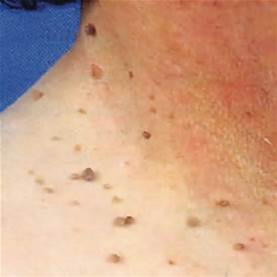A skin tag (also known as an acrochordon) is a small flap or round shaped piece of skin that is attached to the body by a connecting stalk. Skin tags can be smooth or wrinkled, they usually match your skin tone, but can also be slightly darker. Skin tags are usually benign, although any change in shape or color of a skin tag should be examined by your doctor.
Skin tags are common and usually appear around middle age, although if there is a genetic predisposition for moles and skin tags in your family they can appear sooner. Skin tags generally appear in the groin area, under the breasts, armpits, back, chest, eyelids and neck.
Potential causes of skin tags
Skin tags can be indicators of other illness, as well as caused by hormonal fluctuations that are experienced during pregnancy or due to weight gain.
Some of the factors that may contribute to skin tags include:
Metabolic syndrome (Insulin Resistance)
Insulin resistance (additional study)
Prevention
Many people wonder what they can do to prevent skin tags. As with any situation it’s best to get to the root cause. If the root cause is not addressed, and you have them removed, they will come back. If the cause is being overweight, than developing an exercise routine and healthy diet are definitely going to get you on track for improved health.
If you are pre diabetic or diabetic than a discussion with your doctor to get a handle on your blood sugar levels may be in order.
Removal of skin tags
Skin tags are usually removed for cosmetic reasons. Most skin tags are painless, but based on their location they can become bothersome. They can get caught on necklaces, or become irritated from the friction of clothes. Skin tags on the eyelids may become a problem, especially if you rub your eyes frequently.
There are many home remedies for removing skin tags, they usually involve multiple applications a day of a product and can take months to produce results. It isn’t wise to cut or clip skin tags yourself. The skin tag is attached to the body by a stalk. Cutting a skin tag off can result in bleeding, an infection or both. It is always wise to have skin tags removed by your doctor.
Based on the size, quantity and location of your skin tag(s) your doctor may use cryotherapy to freeze it off, remove it surgically in the office with a scalpel or scissors, or use electrical cauterization. Depending on the size and location, a numbing agent may also be used.
If your skin tags aren’t bothering you, leave them alone. But as with any skin growth, if there is a change in the appearance, color or size be sure to have your doctor take a look.








